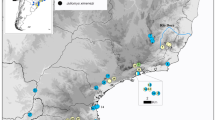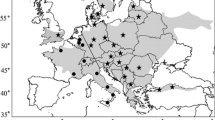Abstract
Fat dormouse is a squirrel-like rodent which is closely tied to deciduous forest ecosystem in southwestern Eurasia. As such it is a valuable indicator of forest survival in refugia during glacial-interglacial periods. Previous phylogeographic analyses uncovered divergent fat dormouse lineages in southern refugia in Italy and the Balkans, but retrieved a surprisingly low overall genetic diversity across the majority of the species’ range. We explored 812 bp long fragment of a cytochrome b (cyt b) gene in ten fat dormice from refugial Hyrcanian forests in northern Iran. We identified 10 new cyt b haplotypes, which generated a total dataset of 28 fat dormouse haplotypes. The phylogenetic reconstruction clustered the new haplotypes into the Iranian lineage which hold a sister position against all other fat dormouse haplotypes from Europe and Asia Minor. The divergence between these lineages suggests a fragmentation event of an ancestral population at 5.76 mya (95% HPD = 3.21–8.92). This early evolutionary divergence was possibly triggered in the Middle East by dramatically divergent environmental conditions at the Messinian Salinity Crisis. The divergence clearly exceeds the intraspecific divergence, and is well within the range between congeneric rodent species. We suggest a long-term persistence of the Iranian lineage in the Hyrcanian refugium which is consitent with a high number of endemics along the southern Caspian coastal areas.
Similar content being viewed by others
References
Akhani, H., Djamali, M., Ghorbanalizadeh, A., Ramezani, E., 2010. Plant biodiversity of Hyrcanian relict forests, N Iran: an overview of the flora, vegetation, palaeoecology and conservation. PakistanJournal of Botany 42, 231–258 (Special Issue).
Amori, G., Hutterer, R., Krystufek, B., Yigit, N., Mitsain, G., Munoz, L.J.P., Meinig, H., Juskaitis, R., 2008. Glis glis. In: IUCN 2012. IUCN Red List of Threatened Species. Version 2012.2, Available at: https://doi.org/www.iucnredlist.org (accessed on 25.03.13).
Avise, J.C., 2000. Phylogeography: The History of Formation of Species. Harvard University Press, Cambridge, MA.
Baker, R.J., Bradley, R.D., 2006. Speciation in mammals and the genetic species concept. Journal of Mammalogy 87, 643–662.
Bandelt, H.J., Forster, P., Röhl, A., 1999. Median-joining networks for inferring intraspecific phylogenies. Molecular Biology and Evolution 16, 37–48.
Bentz, S., Montgelard, C., 1999. Systematic position of the African dormouse Graphiurus (Rodentia, Gliridae) assessed from cytochrome b and 12S rRNA mitochondrial genes. Journal of Mammalian Evolution 6, 67–83.
Bernatchez, L., Wilson, C.C., 1998. Comparative phylogeography of nearctic and palearctic fishes. Molecular Ecology 7, 431–452.
Bilton, D.T., Mirol, P.M., Mascheretti, S., Fredga, J., Zima, J., Searle, J.B., 1998. Mediterranean Europe as anareaofendemism for small mammals rather than a source for northwards postglacial colonization. Proceedings of the Royal Society B, Biological Sciences 265, 1219–1226.
Bright, P.W., Morris, P.A., 1993. Foraging behaviour of dormice Muscardinus avellanarius intwo contrasting habitats. Journal of Zoology 230, 69–85.
Castiglia, R., Annesi, F., Cattaneo, C., Grano, M., Milana, G., Amori, G., 2012. A new mitochondrial lineage in the edible dormouse, Glis glis (Rodentia: Gliridae), from Alonissos island (Sporades archipelago, Greece). Folia Zoologica 61, 177–180.
Conroy, C.J., Cook, J.A., 2000. Molecular systematics of a holarctic rodent (Microtus: Muridae). Journal of Mammalogy 81, 344–359.
Daams, R., de Bruijn, D., 1995. A classification of the Gliridae (Rodentia) on the basis of dental morphology. Hystrix (N. S.) 6, 3–50.
Drummond, A., Rambaut, A., 2007. BEAST: Bayesian evolutionary analysis by sampling trees. BMC Evolutionary Biology 7, 214.
Eastwood, W.J., 2004. East Mediterranean vegetation and climate change. In: Griffiths, H.I., Krystufek, B., Reed, J.M. (Eds.), Balkan Biodiversity: Pattern and Process in the European Hotspot. Kluwer Academic Publishers, Dordrecht, pp. 25–48.
Ewing, B., Hillier, L., Wendl, M.C., Green, P., 1998. Base-calling of automated sequencer traces using Phred. I. Accuracy assessment. Genome Research 8, 175–185.
Excoffier, L., Laval, G., Schneider, S., 2005. Arlequin version 3.0: an integrated software package for population genetics data analysis. Evolutionary Bioinformatics Online 1, 47–50.
Gautier, F., Clauzon, G., Suc, J.P., Cravatte, J., Violanti, D., 1994. Age and duration of the Messinian salinity crisis. Comptes Rendus de l’Académie des Sciences, Paris (IIA) 318, 1103–1109.
Graur, D., Martin, W., 2004. Reading the entrails of chickens: molecular timescales of evolution and the illusion of precision. Trends in Genetics 20 (2), 80–86.
Guindon, S., Gascuel, O., 2003. A simple, fast, and accurate algorithm to estimate phylogenies by maximum likelihood. Systematic Biology 52, 696–704.
Haynes, S., Jaarola, M., Searle, J.B., 2003. Phylogeography of the common vole (Microtus arvalis) with particular emphasis on the colonization of the Orkney archipelago. Molecular Ecology 12, 951–956.
Helvaci, Z., Renaud, S., Ledevin, R., Adriaens, D., Michaux, J., Colak, R., Kankilic, T., Kandemir, I., Yigit, N., Colak, E., 2012. Morphometric and genetic structure of the edible dormouse (Glis glis): a consequence of forest fragmentation in Turkey. Biological Journal of the Linnean Society 107, 611–623.
Hewitt, G.M., 1999. Post-glacial re-colonization of European biota. Biological Journal of the Linnean Society 68, 87–112.
Hewitt, G.M., 2000. The genetic legacy of the Quaternary ice ages. Nature 405, 907–913.
Hewitt, G.M., 2004. The structure of biodiversity ‒ insight from molecular phylogeography. Frontiers in Zoology 1, 4 (26.10.04).
Ho, S.Y.W., Phillips, M.J., Cooper, A., Drummond, A.J., 2005. Time dependency of molecular rate estimates and systematic overestimation of recent divergence times. Molecular Biology and Evolution 22, 1561–1568.
Huelsenbeck, J.P., Ronquist, F., 2001. MrBayes: Bayesian inference of phylogeny. Bioinformatics 17, 754–755.
Hürner, H., Krystufek, B., Sarà, M., Ribas, A., Ruch, T., Sommer, R., Ivashkina, V., Michaux, J.R., 2010. Mitochondrial phylogeography of the edible dormouse (Glis glis) in the Western Palearctic Region. Journal of Mammalogy 91, 233–242.
Jaarola, M., Searle, J.B., 2002. Phylogeography of field voles (Microtus agrestis) in Eurasia inferred from mitochondrial DNA sequences. Molecular Ecology 11, 2613–2621.
Kelt, D.A., Brown, J.H., Heske, E.J., Marquet, P.A., Morton, S.R., Reid, J.R.W., Rogovin, K.A., Shenbrot, G., 1996. Community structure of desert small mammals: comparisons across four continents. Ecology 77, 746–761.
Kowalski, K., 2001. Pleistocene rodents of Europe. Folia Quaternaria 72, 3–389.
Krystufek, B., 2010. Glis glis (Rodentia: Gliridae). Mammalian Species 42 (865), 195–206.
Krystufek, B., Vohralík, V., 2005. Mammals of Turkey and Cyprus. Rodentia I: Sciuridae, Dipodidae, Gliridae, Arvicolinae. Založba Annales, Koper.
Lo Brutto, S., Sará, M., Arculeo, M., 2011. Italian Peninsula preserves an evolutionary lineage ofthe fat dormouse Glis glis L. (Rodentia: Gliridae). Biological Journal of the Linnean Society 102, 11–21.
Maldonado, A., 1985. Evolution of the Mediterranean basins and a detailed reconstruction of the Cenozoic paleoceanography. In: Margalef, R. (Ed.), Key Environments. Western Mediterranean. Pergamon Press, Oxford, pp. 17–59.
Martin, A.P., Palumbi, S.R., 1993. Protein evolution in different cellular environments: cytochrome b in sharks and mammals. Molecular Biology and Evolution 10, 873–891.
McKenzie, J.A., 1999. From desert to deluge in the Mediterranean. Nature 400, 613–614.
Michaux, J.R., Magnanou, E., Paradis, E., Nieberding, C., Libois, R., 2003. Mitochondrial phylogeography of the Woodmouse (Apodemus sylvaticus) in the Western Palearctic region. Molecular Ecology 12, 685–697.
Mouton, A., Grill, A., Sarà, M., Kryštufek, B., Randi, E., Amori, G., Juskaitis, R., Aloise, G., Mortelliti, A., Panchetti, F., Michaux, J., 2012. Evidence of a complex phylogeographic structure in the common dormouse, Muscardinus avellanarius (Rodentia: Gliridae). Biological Journal of the Linnean Society 105, 648–664.
Musser, G.G., Carleton, M.D., 2005. Superfamily Muroidea. In: Wilson, D.E., Reeder, DAM (Eds.), Mammal Species of the World. A Taxonomic and Geographic Reference, vol. 2, 3rd ed. John Hopkins University Press, Baltimore, CA, pp. 894–1531.
Nylander, J.A.A., 2004. Mrmodeltes, Version 2.2. Uppsala University, Department of Systematic Zoology, Uppsala.
Perez, G.C.L., Libois, R., Nieberding, C.M., 2013. Phylogeography ofthe garden dormouse Eliomys quercinus in the western Palearctic region. Journal of Mammalogy 94, 202–217.
Posada, D., 2008.JModelTest: phylogenetic model averaging. Molecular Biology and Evolution 25, 1253–1256.
Posada, D., Crandall, K.A., 1998. Modeltest: testing the model of DNA substitution. Bioinformatics 14, 817–818.
Rambaud, A., Drummond, A.J., 2007. TRACER, Version 1.4, Available at: https://doi.org/beast.bio.ed.ac.uk/Software/Tracer
Rambaut, A., Drummond, A.J., 2009. TRACER v1.5, Available at: https://doi.org/beast.bio.ed.ac.uk/Software/Tracer
Röhrig, E., 1991. Deciduous forests of the Near East. In: Röhrig, E., Ulrich, B. (Eds.), Ecosystems of the World 7: Temperate Deciduous Forests. Elsevier, Amsterdam, pp. 527–537.
Ronquist, F., Huelsenbeck, J.P., 2003. MRBAYES 3: Bayesian phylogenetic inference under mixed models. Bioinformatics 19, 1572–1574.
Rozas, J., Sanchez-DelBarrio, J.C., Messeguer, X., Rozas, R., 2003. DNASP, DNA polymorphism analyses by the coalescent and ot her methods. Bioinformatics 19, 2496–2497.
Shen, X.J., Tsudzuki, H., Nakamura, T., 1999. Primer design and sequence information forcytochrome b gene in the Chinese painted quail (Excalfactoria chinensis). Animal Science Journal 70, 240–242.
Shimodaira, H., Hasegawa, M., 1999. Multiple comparisons of log-likelihoods with applications to phylogenetic inference. Molecular Biology and Evolution 16, 1114–1116.
Svenning, J.C., Normand, S., Kageyama, N., 2008. Glacial refugia of temperate trees in Europe: insights from species distribution modelling. Journal of Ecology 96, 1117–1127.
Swofford, D.L., 2002. PAUP*. Phylogenetic Analysis using Parsimony (*and Other Methods). Version 4.0b10. Sinauer Associates, Sunderland, MA.
Tamura, T., Peterson, D., Peterson, N., Stecher, G., Nei, M., Kumar, S., 2011. MEGA5: molecular evolutionary genetics analysis using maximum likelihood, evolutionary distance, and maximum parsimony methods. Molecular Biology and Evolution 28, 2731–2739.
Tarkhnishvili, D., Gavashelishvili, A., Mumladze, L., 2012. Palaeoclimatic models help to understand current distribution of Caucasian forest species. Biological Journal ofthe Linnean Society 105, 231–248.
Ünay, E., 1994. Early Miocene rodent faunas from the eastern Mediterranean area: Part IV. The Gliridae. In: Proceedings of the Koninklijke Nederlandse Akademie van Wetenschappe, Ser. B 97, pp. 445–490.
West, R.G., 1977. Pleistocene Geology and Biology with Special Reference to the British Isles. Longman, London.
Yannic, G., Burri, R., Malikov, V.G., Vogel, P., 2012. Systematics of snow voles (Chionomys, Arvicolinae) revisited. Molecular Phylogenetics and Evolution 62, 806–815.
Author information
Authors and Affiliations
Corresponding author
Rights and permissions
About this article
Cite this article
Naderi, G., Kaboli, M., Koren, T. et al. Mitochondrial evidence uncovers a refugium for the fat dormouse (Glis glis Linnaeus, 1766) in Hyrcanian forests of northern Iran. Mamm Biol 79, 202–207 (2014). https://doi.org/10.1016/j.mambio.2013.12.001
Received:
Accepted:
Published:
Issue Date:
DOI: https://doi.org/10.1016/j.mambio.2013.12.001




